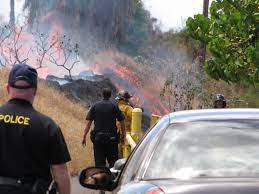At CISP, our hearts go out to all those affected by the terrible August fires on Maui. May the departed rest in peace. May the living find comfort and all that is needed for recovery.
Fire and Invasive Grasses
Major U.S. and international media continue to detail the fires’ devastation, especially in Lahaina. As time has passed, more news has highlighted the role that the widespread presence of introduced, fire-prone grasses played in the rapid growth and spread of Maui’s fires.
For example, The Washington Post devoted seven paragraphs in one story to the issue of grasses. The story quotes several experts: Alison Nugent, an associate atmospheric scientist at the University of Hawaii’s Water Resources Research Center; Jeff Masters, a meteorologist for Yale Climate Connections; and Clay Trauernicht, a fire researcher at the University of Hawaii.
These and others have been widely quoted in the many recent articles. I am glad that they – and the media – are making clear that climate change is not the sole factor causing damaging wildfires. It is clear that Maui’s recent weather patterns – including the high-velocity winds and drought – have been within the range of normal climate patterns. Fluctuations in the Pacific’s weather have also been normal, especially under the influence of the current El Niño.
The dangers caused by Hawai’i’s fire-prone grasses are also clear – and have been for years. Experts have identified policy weaknesses at the county and state level. Also, they have specified changes to land management that could better prevent or mitigate wildfires. There has been far too little action.
On the other hand, there are hopeful signs.
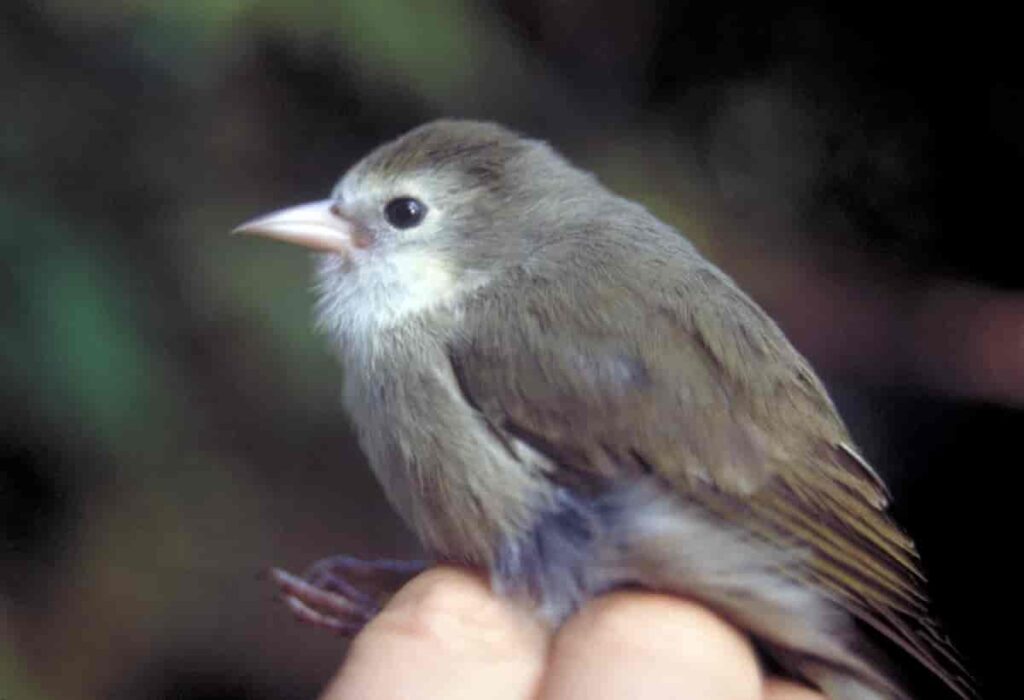
endangered ‘akikiki photo by Carter Atkinson, USGS
The Hawai’i Wildfire Management Organization, a nonprofit, is educating and engaging communities state-wide. Elizabeth Pickett, a Co-Executive Director, presented an overview of wildfire at the Hawai’i Invasive Species Awareness Month in February 2023. The Big Island Invasive Species Committee has successfully eradicated two species of pampas grass on Hawai’i Island – after 13 years’ work. A native species has been planted where pampas formerly grew.
Another Post article reported on efforts by staff and fire departments to protect the Maui Bird Conservation Center, which houses critically endangered Hawaiian birds found nowhere else on Earth, including some currently extinct in the wild. As I have blogged previously, the palila, kiwikiu, ‘akikiki, ‘alalā [Hawaiian crow; extinct in the wild] and other birds are dying from avian malaria, carried by nonnative mosquitoes. The Center on Maui and another on the Big Island are run by the San Diego Zoo Wildlife Alliance. Conservationists have completed field trials of a proposed mosquito suppression process for Maui and are seeking public comments for a similar program on Kaua’i. These programs represent groundbreaking and long-awaited progress on countering a principal threat to the survival of Hawai`i’s unique avifauna. Loss of the Center and its birds would have devastated post-suppression efforts to rebuild and restore bird populations in the wild.
The Post carried a second story about the effort to protect Hawai`i’s endangered birds – a full page of print, even longer – with many photos, on the web. The article mentions the “Birds, Not Mosquitoes” program and varying views about it. I rejoice that the dire situation for the Islands’ biodiversity is getting attention in the Nation’s capital. Again, see my earlier blog.
Plant Invasions in Hawaiian Forests
A team of scientists from the USDA Forest Service and Natural Resources Conservation Service, plus the Hawaii Division of Forestry and Wildlife, has carried out a new assessment of the extent of invasive plant species in forests on the Hawaiian Islands (Potter et al. 2023; full citation at end of blog).
The results of their analysis are – in their words – “sobering”. They portend “a more dire future for Hawai`i`s native forests.”
First, regarding the recent fires, Potter et al. found significantly higher cover by invasive grasses on Forest and Inventory Analysis (FIA) plots on Hawai‘i and Maui than on O‘ahu, Kaua‘i, and Lana‘i. Grass invasions were particularly high on the eastern coast of Maui – near Lahaina. Even so, the authors say their study’s methods resulted in a gross underestimate of areas invaded by fire-prone grasses. That is, most of Hawai’i’s xerophytic dry forests were converted to grasslands before the FIA program began. Therefore these grasslands are not included in FIA surveys.
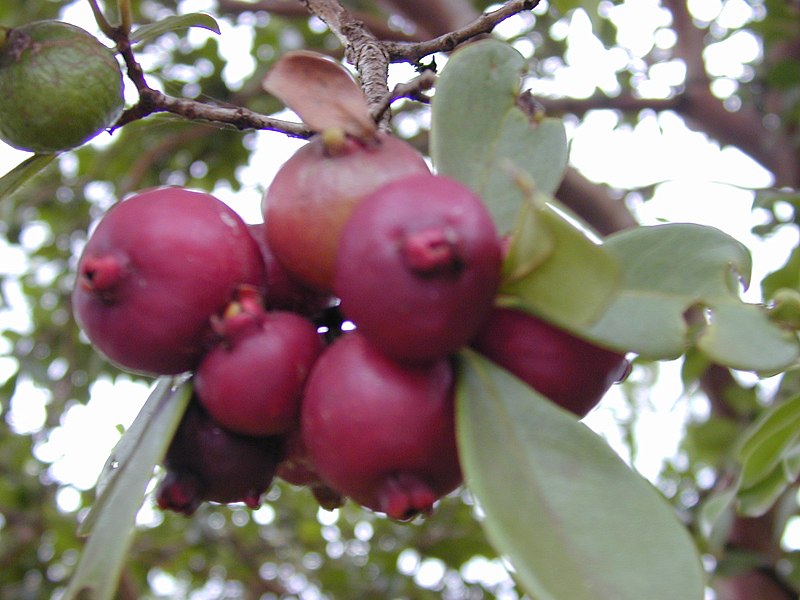
The extent of current invasions in wetter forests is already significant – but trends point to an even more worrying future.
- Naturalized non-native plant taxa constitute half of the Hawaiian flora.
- 56% of Hawaii’s 553,000 ha of forest land contained non-native tree species; about 39% of these forest lands are dominated by non-native tree species. Invasive plant species of particular concern were found in the understory of 27% of surveyed forest plots.
- Across all islands, six of the ten most abundant species are non-native: Psidium cattleyanum, Schinus terebinthifolius, Leucaena leucocepahala, Ardisia elliptica, Psidium guajava, and Acacia confusa.
- While less than one-third (29%) of large trees across the Islands are non-native, this proportion increases to about two-thirds of saplings (63%) and seedlings (66%). Potter et al. focus on the likelihood that plant succession will result in transformation of these forests’ canopies from native tree species to non-native species.
- 75% of forests in lower-elevation areas of all islands are already dominated by non-native tree species. “Only” 31% of higher-elevation forests are so dominated. These montane forests have been viewed as refugia for native species, but all are invaded to some extent – and likely to become more degraded.
- Potter et al. say the high elevation forests might be more resistant to domination by non-natives. Such a result would be counter to well-documented experience, though. Even the authors report that the montane rainforests and mesophytic forests of O‘ahu and Kaua‘i are heavily invaded by non-native tree species. Such species constitute 86% or more of large trees, saplings, and seedlings in mesophytic forests; 45% of large trees and 66% of seedlings in their montane rainforests.
- The most abundant tree species in Hawai`i is the invasive species Psidium cattleyanum (strawberry guava). It was recorded on 88, or37%, of 238 FIA plots. There are nearly twice as many P. cattleyanum saplings as Hawai`i’s most widespread native species, ‘ohi’a lehua (Metrosideros polymorpha).
- Widescale replacement of native trees by non-native species is likely. Several factors favor these changes: 1) tree disease – rapid ‘ohi’a death has had drastic impacts on ‘ohi’a populations on several islands; 2) invasions by forbs and grasses; 3) soil damage and other disturbances caused by invasive ungulates; and 4) climate change. If succession conforms to these trends, non-native tree species could eventually constitute 75% or more of the forest tree stems and basal area on all islands and across forest types and elevations.
Loss of Hawai’i’s native tree species would be disastrous for biodiversity at the global level. More than 95% of native Hawaiian tree species are endemic, occurring nowhere else in the world.
The authors analyzed plant presence data from 238 FIA plots. Plots spanned the state’s various climates, soils, elevations, gradients, ownership, and management. However, access issues precluded inclusion of forests from several islands: Moloka‘i, Kaho’olawe, and Ni‘ihau. I know that Moloka‘i, at least, has a protected forest reserve (a Nature Conservancy property) at the island’s highest elevations.
Protecting Native Trees
Federal, state, and private landowners have carried out numerous actions to protect native forests. These efforts might be having some success. For example, forests on public lands, in conservation reserves, or in areas fenced to exclude ungulates were less impacted by non-native plants than unfenced plots, on average. However, the authors could not determine how much of this difference was the result of management or because protections were established in forests with the lowest presence of IAS species. Fencing did not prevent invasions by forbs and grasses – possibly because they are so widespread that seed sources are everywhere.
Hawaii’s two National parks (Hawai`i Volcanoes and Haleakala) have made major efforts to control invasive plants. Hawai`i Volcanoes, on the Big Island, began its efforts in the 1980s; Haleakala (on Maui) more recently. This might be one explanation for the fact that a smaller proportion of the forests on these two islands have been invaded. These efforts have not fully protected the parks, however. Low elevation native rainforests now have a high presence of non-native shrubs. Such forests on Hawai`i Island also have significant invasions by non-native woody vines, forbs and grasses.
More discouraging, intensive efforts have not returned lowland wet forest stands to a native-dominated state. Native tree species are not regenerating—even where there is plentiful seed from native canopy trees and managers have repeatedly removed competing non-native understory plants.
Potter et al. conclude that other approaches will be needed. They suggest deliberate planting of native and non-invasive non-native species or creation of small artificial gaps that might facilitate recovery of native tree species. In montane forests on Hawai`i and Maui, where native tree seedlings account for more than 70% of all tree seedlings, they propose enhancing early detection/rapid response efforts targetting invasive forbs. This would include both National parks.Certainly Haleakala National Park has this priority in mind. It launched a serious effort to try to eradicate Miconia calvescens when this tree first was detected.
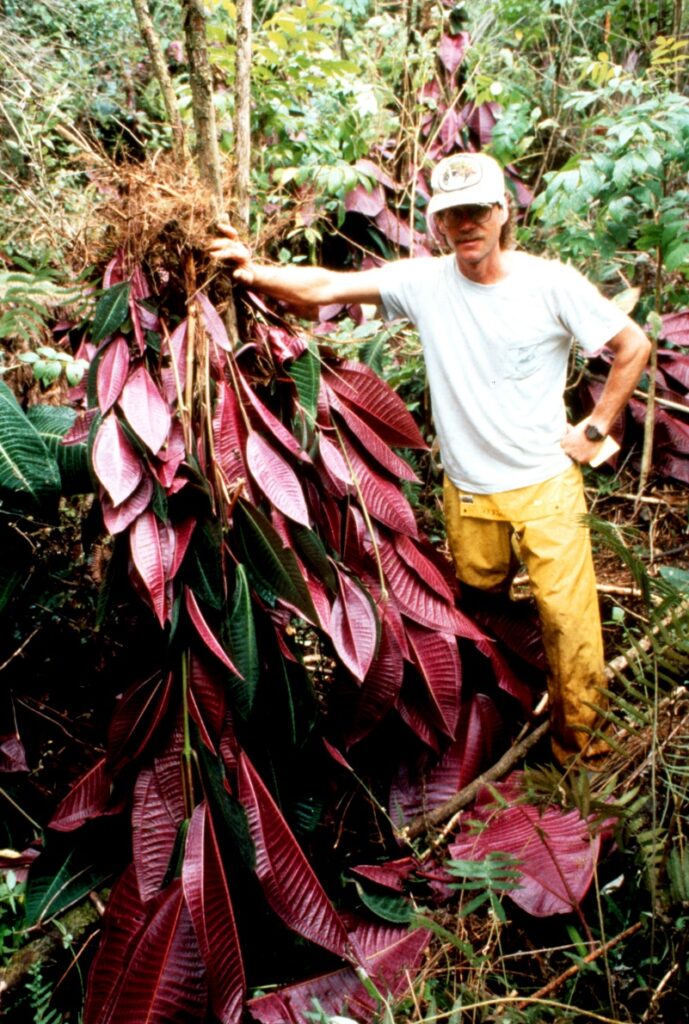
Potter et al. note the challenge of managing remnant xerophytic dry forests, where natural regeneration of native plants has been strongly limited by invasive grasses; loss of native pollinators and seed dispersers; and the increasing frequency and intensity of droughts. They note that expanded management efforts must be implemented for decades, or longer, to be successful.
Native Trees at Risk to Nonnative Insects
Beyond the scope of the Potter et al. study is the fact that at least two dry forest endemic trees have faced their own threats from non-native insects.
The Erythrina gall wasp, Quadrastichus erythrinae, appeared in Hawai`i in 2005; it originates in east Africa. It attacks the endemic tree, wiliwili, Erythrina sandwicensis. I believe a biocontrol agent, Eurytoma erythrinae, first released in 2008, has effectively protected the wiliwili tree, lessening this threat.
The Myoporum thrips, Klambothrips myopori, from Tasmania, was detected on the Big Island in 2009. It threatens a second native tree. Naio, (Myoporum sandwicense), grows in dry forests, lowlands, upland shrublands, and mesic and wet forest habitats from sea level to 3000 m. The loss of this species would be both a signifcant loss of native biodiversity and a structural loss to native forest habitats. The thrips continues to spread; a decade after the first detection, it was found on the leeward (dry) side of Hawai`i Island with rising levels of infestation and tree dieback.
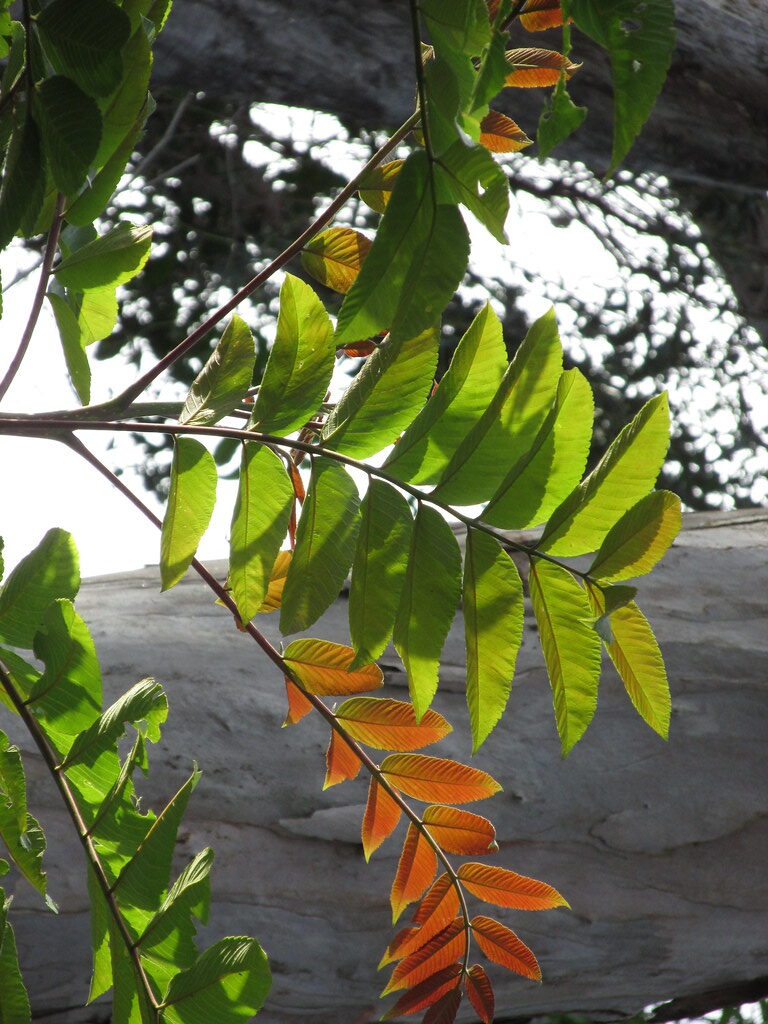
Two native shrubs, Hawaiian sumac Rhus sandwicensis and Dodonea viscosa, might be at risk from a biocontrol agent in the future. APHIS has approved a biocontrol for the highly invasive Brazilian pepper, Schinus terebinthifolia. Brazilian pepper is the second-most abundant non-native tree species in the State. It was found on 28 of 238 (12%) FIA plots. However, the APHIS-approved biocontrol agent is a thrips—Pseudophilothrips ichini. It is known to attack both of these two native Hawaiian shrubs. The APHIS approval allowed release of the thrips only on the mainland US. However, many insects have been introduced unintentionally from the mainland to Hawai`i. Furthermore, Hawaiian authorities were reported to be considering deliberate introduction of P. ichini to control peppertree on the Islands.
In Conclusion
In conclusion, Potter et al. found that most Hawaiian forests are now hybrid communities of native and non-native species; indeed, a large fraction are novel forests dominated by non-native trees. Business-as-usual management will probably mean that the hybrid forests – and probably those in which the canopy is currently dominated by native species—will follow successional trajectories to novel, non-native- dominated woodlands. This likelihood results in a more dire future for native plants in Hawaiian forests than has been previously described.
Potter at al. hope that their findings can guide research and conservation on other islands, especially those in the Pacific. However, Pacific islands already have the most naturalized species globally for their size—despite what was originally considered their protective geographic isolation.
SOURCE
Potter, K.M., C. Giardina, R.F. Hughes, S. Cordell, O. Kuegler, A. Koch, E. Yuen. 2023. How invaded are Hawaiian forests? Non-native understory tree dominance signals potential canopy replacement. Landsc Ecol https://doi.org/10.1007/s10980-023-01662-6
Posted by Faith Campbell
We welcome comments that supplement or correct factual information, suggest new approaches, or promote thoughtful consideration. We post comments that disagree with us — but not those we judge to be not civil or inflammatory.
For a detailed discussion of the policies and practices that have allowed these pests to enter and spread – and that do not promote effective restoration strategies – review the Fading Forests report at http://treeimprovement.utk.edu/FadingForests.htm
or
